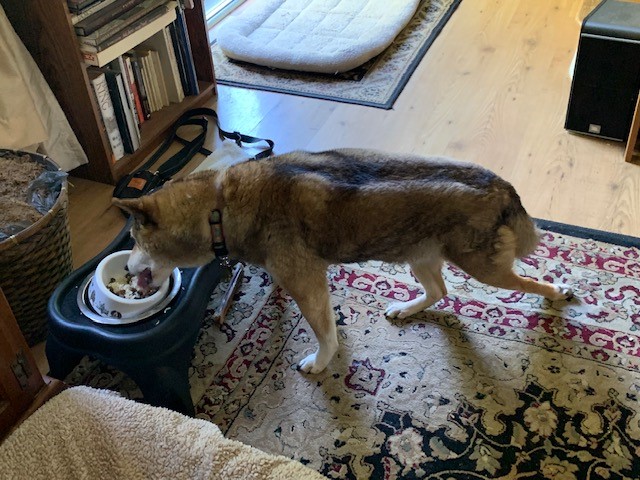
When Betty Grosvenor wrote to me about her roller coaster experience finding the right veterinary care for her dog Sandy, I knew it was a story I wanted to share. Sandy went from being a healthy 13-year-Shiba Inu one week, to a dog who couldn’t stand on her own, a few weeks later.
Their story reminded me that medicine doesn’t follow a straight line. There are mishaps, disappointments and changes that send you on a new path.
Each time Betty faced a challenge, like a veterinarian being out-of-town or lacking the proper skills, she turned in a new direction to find answers. She became Sandy’s advocate as well as her pet mom.
Ultimately, it was the small pivots that led Betty to the right professionals who could heal her dog.
Betty and Sandy’s story

Last February, Sandy walked into a room with a strange sway in her back end. Betty looked her over, but couldn’t find anything wrong. She watched Sandy overnight and when the wobbly walk was still there the next morning, she took Sandy to their veterinarian.
The vet diagnosed the problem as pulled a muscle. It was a condition Sandy had once before and she completely healed at the time. So the veterinarian injected the dog with a steroid for inflammation and sent her home with medication for pain.
Sandy had been healthy her whole life and Betty fully expected her to rebound from this latest incident. After a couple of days, she seemed slightly better, but then things got worse. Sandy started walking with a more pronounced sway in her step and weakness in her hind legs. Betty began to worry.
“The first thing I wanted to do was Google Sandy’s symptoms, but I told myself to stay away from the computer. I knew it would make me more anxious. But I couldn’t help myself. I sat down at the computer and typed in the Sandy’s symptoms. What I found worried me to death,” said Betty.
The next day Betty and Sandy traveled back to the vet. X-rays were taken, but according to the veterinarian, they didn’t show anything abnormal in Sandy’s spine. In fact, Betty was told that Sandy had “the spine of a 5-year-old dog.” Sandy got an injection for pain and the two went home.
Over the next couple of weeks, Sandy’s ability to walk went from swaying to stumbling. Their vet recommended they see a neurologist. Unfortunately, they couldn’t get an appointment right away.
“I was overwhelmed not knowing the cause of Sandy’s problem or how to take care of her,” said Betty.

eBook
Find The Right Dog Wheelchair For Your Pet
Your dog has a mobility problem, and you want to buy a wheelchair. But do you know what kind of cart will work best for your dog’s individual needs? After a decade of teaching pet owners how to make the right choice, I put the information into an eBook!
A lucky chance meeting
A friend suggested that Betty call a veterinarian who makes house calls. When the she arrived, she reviewed the x-rays Sandy had taken at their primary vet’s office. Surprisingly, the new veterinarian came up with a completely different diagnosis. She explained that several discs in Sandy’s spine were out of alignment. The vet thought the dog probably suffered a herniated disc. Her recommendation was to place Sandy on crate rest for four weeks.
The vet also referred Betty to Dr. Shelagh McCaffrey, who specializes in senior pet health. She thought Sandy would be a great candidate for acupuncture.
Betty took the orders seriously. She put together a fenced area in her home where Sandy could lie comfortably, be safe from injuring her spine and easily see her family.
Sandy, didn’t see her new home in the same light. According to Betty she fussed and screamed and pulled the fence apart. Still, Betty stayed firm and kept Sandy confined for the full four weeks.
Seeing the neurologist

Finally, it was time to visit the neurologist. Betty thought she’d finally find the right veterinary care for Sandy. At this point the dog wasn’t able to walk, at all.
The neurologist recommended that Sandy undergo an MRI to get more details about the condition of her spine. The cost was prohibitive for Betty’s family, so instead the vet ordered Sandy to have four more weeks of crate rest.
He also prescribed several pain medicines and a stronger steroid than she had previously taken. Sandy had a severe reaction to the combination of drugs. The more she took, the more hyperactive she became. Betty said she couldn’t find a way to calm her down.
A second opinion

The reaction to the medicine made Betty wonder if Sandy might need a second opinion. So, they made an appointment with another veterinary neurologist. The exam went well, but the vet’s diagnosis was that Sandy would never walk again.
Betty was asked to consider Sandy’s quality of life and think about euthanizing her rather than have her live as a paraplegic.
Betty was devastated. She had no intention of giving up on her dog.
The duo decided to make another visit to the first neurologist. He recommended that Betty stop looking for answers and consider living with Sandy as a disabled dog. He suggested buying a dog wheelchair and several other mobility devices. Betty left the appointment feeling like this could be a good plan for Sandy’s future.
Finally finding the right veterinary care for Sandy
Once Betty got home, she went to work researching the supplies and equipment Sandy would need. She also decided to call Dr. McCaffrey about acupuncture treatments. Soon after the veterinarian came to their home with her electro-acupuncture equipment in hand. Electro-acupuncture uses low levels of electricity to enhance the therapy. It passes an electric current to the patient through the acupuncture needles to restore nerve function.
Sandy was a good candidate for electro-acupuncture because she never lost the “deep pain” sensations in her hind legs.
Dr. McCaffrey explained that she would give Sandy three treatments and then they would evaluate how the dog was responding.
Here’s how the treatments went:
Session 1 – On day three after the first treatment, Sandy was able to drag herself around.
Session 2 – Sandy’s dragging abilities improved. She was also able to pull herself over obstacles, like the bolsters on her dog bed.
Session 3 – Chinese herbs were added to the regimen to stimulate the nerves endings and improve the blood flow to Sandy’s limbs. After the final acupuncture treatment Sandy was able to push herself up to a standing position and walk on her knees.
“Don’t count these dogs out, just because traditional medicine didn’t work,” said Dr. McCaffrey.
Note: The Chinese herbs Sandy took are called Double P II herbal blend by JingTang and Concentrated DI Huang Yin Zi. Both require a prescription.

Get the Essential Guide
The Essential Guide of Products for Handicapped Dogs e-book is a labor of love for me. I wrote it to answer your most pressing questions about where to find the best products for your wheelchair dog. You’ll find products you didn’t know existed and each will improve your dog’s quality of life. Print a copy and keep it by your side.
Continued improvement

After another three weeks, Sandy was able to take a few steps in her sling. Betty said she acted like an “entirely new dog.”
Then while Betty and her husband were away, they received a video from their son. It showed Sandy standing on her own while she ate dinner. Betty said the video brought her to tears.
When the couple returned from their trip they got an even bigger surprise.
Sandy walked on her own to meet Betty at the door.





Thanks so much for sharing.
I let go of one of my shelties who loss the use of his back legs. The vet didn’t give me other options. When his brother started having issues with his back legs I decided this time I wasn’t going to go the same route and started looking for other answers. Although we don’t use a wheel chair at this point I found a vet to come here to see him, do acupuncture and light therapy on his hips. He’s improved and if we need to it will be a wheelchair for him.
Funds are an issue with medical care since on social security but I do the best I can and will do the best for my boy.
I’m encouraged by the Sandy’s story you shared to keep going and never give up.
Thanks for sharing your story. I think you’re moving in the right direction for your dog. The therapies you mention are very helpful. When it comes time to look for a wheelchair check out my post Organizations That Donate Dog Wheelchairs. It’s a list of the nonprofits that loan and donate carts to pet families.